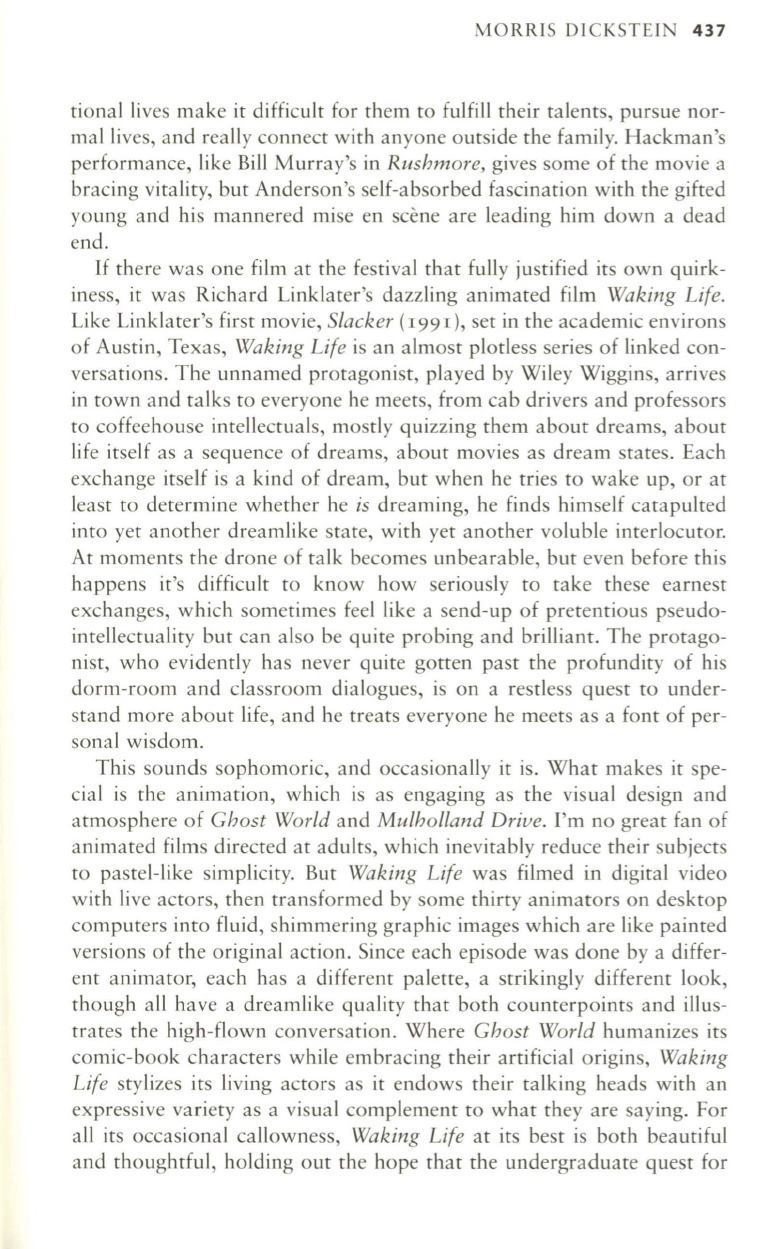
MORRIS DICKSTEIN
437
tiona I lives make it difficult for them to fulfill their talents, pursue nor–
mal lives, and really connect with anyone outside the family. Hackman's
performance, like Bill Murray's in
Rushmore,
gives some of the movie a
bracing vitality, but Anderson's self-absorbed fascination with the gifted
young and his mannered mise en scene are leading him down a dead
end.
If
there was one film at the festival that fully justified its own quirk–
iness, it was Richard Linklater's dazzling animated film
Waking Life.
Like Linklater's first movie,
Slacker
(1991),
set in the academic environs
of Austin, Texas,
Waking Life
is an almost plotless series of linked con–
versations. The unnamed protagonist, played by Wiley Wiggins, arrives
in town and talks to everyone he meets, from cab drivers and professors
to coffeehouse intellectuals, mostly quizzing them about dreams, about
life itself as a sequence of dreams, about movies as dream states. Each
exchange itself is a kind of dream, but when he tries to wake up, or at
least to determine whether he
is
dreaming, he finds himself catapulted
into yet another dreamlike state, with yet another voluble interlocutor.
At moments the drone of talk becomes unbearable, but even before this
happens it's difficult to know how seriously to take these earnest
exchanges, which sometimes feel like a send-up of pretentious pseudo–
intellectuality but can also be quite probing and brilliant. The protago–
nist, who evidently has never quite gotten past the profundity of his
dorm-room and classroom dialogues, is on a restless quest to under–
stand more about life, and he treats everyone he meets as a font of per–
sonal wisdom.
This sounds sophomoric, and occasionally it is. What makes it spe–
cial is the animation, which is as engaging as the visual design and
atmosphere of
Ghost World
and
Mulholland Drive.
I'm no great fan of
animated films directed at adults, which inevitably reduce their subjects
to pastel-like simplicity. But
Waking Life
was filmed in digital video
with live actors, then transformed by some thirty animators on desktop
computers into fluid, shimmering graphic images which are like painted
versions of the original action. Since each episode was done by a differ–
ent animator, each has a different palette, a strikingly different look,
though all have a dreamlike quality that both counterpoints and illus–
trates the high-flown conversation. Where
Ghost World
humanizes its
comic-book characters while embracing their artificial origins,
Waking
Life
stylizes its living actors as it endows their talking heads with an
expressive variety as a visual complement to what they are saying. For
all its occasional callowness,
Waking Life
at its best is both beautiful
and thoughtful, holding out the hope that the undergraduate quest for


